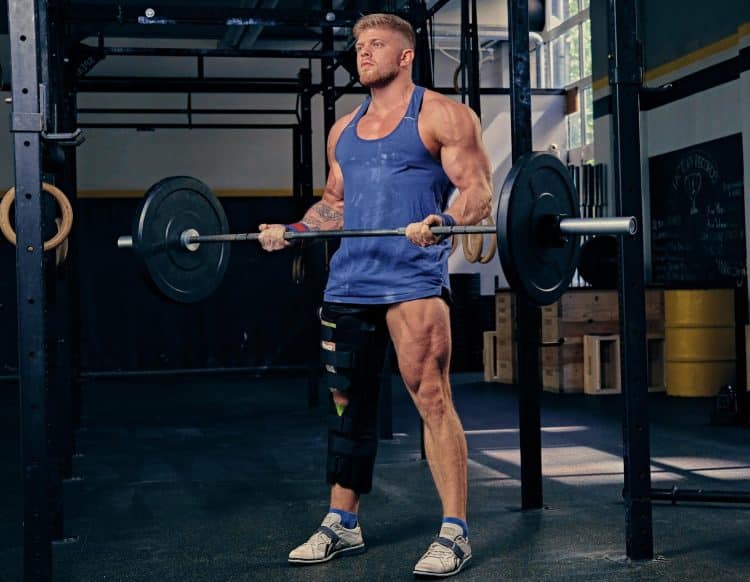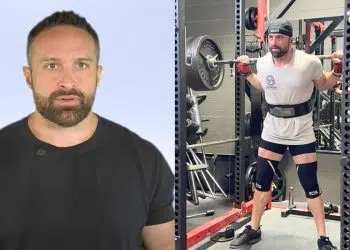Consistency is arguably the most important principle for strength and hypertrophy gains. Provided you train consistently, even poorly planned workouts will produce results. Of course, your gains will be better if you follow a well-designed program. However, missing more than a few workouts will impede your progress.
As a veteran personal trainer with over 30+ years of experience, part of my job is helping clients stick to their training plans. In most cases, simply knowing they have an appointment with me to train means they skip fewer workouts.
Unfortunately, regardless of how dedicated you are, there will be times when it’s impossible for you to train, and a layoff is unavoidable. Reasons for this include:
- Injuries
- Illness
- Low energy
- Feeling overtrained or under-recovered
- Vacations or business trips
- Family or work commitments
- Moving to a new house
While the occasional missed workout won’t cause any harm, a couple of weeks or more away from the gym will start to eat away at your gains.
In this article, I reveal the strategies I use to maintain muscle and strength during planned and unplanned layoffs.
How Quickly Will You Lose Muscle and Strength?
Level Up Your Fitness: Join our 💪 strong community in Fitness Volt Newsletter. Get daily inspiration, expert-backed workouts, nutrition tips, the latest in strength sports, and the support you need to reach your goals. Subscribe for free!
Your muscles grow (hypertrophy) and get stronger in response to training. Lifting weights stresses your muscles, and they respond by adapting to your workouts so they’re better able to cope next time.
Of course, provided you employ the progressive resistance method, your next workout will be slightly more challenging, and your progress should continue.
However, remove that stimulus by missing workouts, and your muscles will return to their pre-trained state. In other words, your muscles will start to get weaker and smaller. This is called muscle atrophy.
But how quickly will you lose strength and muscle mass? Unfortunately, this is a hard question to answer because many variables are at play.
For example, older lifters tend to lose muscle faster than younger lifters (1). Similarly, people with a long history of consistent training usually lose their gains more slowly than novices. In addition, someone who is entirely sedentary, e.g., immobilized in hospital, will lose muscle faster than someone who remains moderately active.
All that said, research suggests that most people start losing their gains after two to three weeks of not training (2).
While you may feel weaker or less muscular before this, your muscle mass isn’t affected. Instead, you look smaller because of muscle glycogen (stored glucose) depletion. In contrast, strength decreases are due to reduced neural efficiency. In short, your muscles “forget” how to generate maximal force.
The good news is that regaining muscle and strength takes less time than building them in the first place. We often call this phenomenon “muscle memory.” You can also take steps to minimize muscle loss during a layoff.
7 Ways to Maintain Muscle During a Layoff
Building muscle and strength is hard work, and it would be a shame to lose your gains just because you are forced into a layoff. In this section, I reveal the strategies I use with my clients to help preserve their gains or minimize atrophy during planned and unplanned breaks from training.
Please note: If you are injured, you’ll probably need to stop training the affected area to allow it to heal. Don’t work out if doing so will worsen the injury or delay your recovery.
1. Stay Active
Sedentary people lose muscle faster than those who remain relatively active. A few years ago, I had to have one leg immobilized in a plaster cast. While the cast was only on for a week, I lost an appreciable amount of muscle.
In contrast, during another enforced layoff, several weeks this time, I made sure that I walked every day and looked for other ways to remain active. I lost no muscle during this time.
So, don’t become lazy during a layoff. Just because you can’t go to the gym doesn’t mean you have to sit on your couch and wallow in self-pity! Get up and move to preserve fitness, strength, and mental health.
2. Do Calisthenics or Isometric Training
While the gym is arguably the best place to build muscle and strength, getting to one is not always possible. For example, you may have to travel for work, so access to a gym is limited. Or, you may be on vacation, and there is no gym where you are staying.
The good news is that you don’t need state-of-the-art training equipment to maintain muscle and strength. In fact, all you need is your body, some space, and maybe a towel or yoga strap.
Research suggests that bodyweight exercises like push-ups can be as effective as bench presses for working the pecs (3). So, it stands to reason that you can do pull-ups instead of pulldowns or air squats instead of leg presses to preserve muscle and strength. Read more about calisthenics here.
A simple workout of push-ups, pull-ups, and bodyweight squats works all your major muscles and will act as an effective hold-over until you can get back in the gym.
Level Up Your Fitness: Join our 💪 strong community in Fitness Volt Newsletter. Get daily inspiration, expert-backed workouts, nutrition tips, the latest in strength sports, and the support you need to reach your goals. Subscribe for free!
Alternatively, you can use isometric or static training to maintain or even increase muscle size and strength (4). Isometrics involve pushing or pulling against an immovable object, e.g., a yoga strap, iso-trainer, towel, or an opposing limb.
Read more about isometric training in these detailed guides:
- Isometrics for Injury Prevention and Building Strength and Muscle
- The Science of Isometric Training — Explained!
3. Break Out the Resistance Bands
No time to go to the gym? No problem! Studies indicate that you can maintain or even build muscle and strength with a set of resistance bands (5). You can use resistance bands to replicate all the freeweights and machines you use at the gym. Keep a set in your luggage when traveling so you never need to miss a workout.
As an added benefit, resistance bands are often easier on your joints than conventional weights, so they’re an excellent option when returning from injury. Even a few minutes of resistance band training per day will help reduce muscle loss during a gym layoff.
4. Maintain Your Protein Intake
Most exercisers know how important protein is for muscle building. Protein contains the amino acids your muscles need for repair and growth. This is why most bodybuilders and serious lifters build their diets around protein.
However, studies suggest that protein is as crucial during a layoff as it is when you are training. Maintaining a high protein intake could help reduce muscle breakdown during your training hiatus (6).
How much protein you need depends on your body weight, but most experts agree that between 1.2 to 2.0 grams per kilogram is sufficient. However, you can get a more precise recommendation with our protein intake calculator.
5. Consume Maintenance-Level Calories
While you might be tempted to eat less during a layoff to minimize weight gain, cutting your food intake could accelerate muscle and strength loss. That’s because when energy is in short supply, your body will catabolize lean tissue for fuel, accelerating muscle loss.
So, while you should avoid overeating during a training break, which will invariably lead to fat gain, don’t starve yourself, either. Instead, consume as many kilocalories as you burn to make sure you’re in energy balance.
Use this TDEE calculator to determine your daily energy needs.
6. Employ Micro Workouts to Preserve Muscle and Strength
Building muscle and strength usually means many hours of training each week. However, you can maintain your gains with much less training time. In fact, researchers estimate that you can reduce your training volume by two-thirds or more without losing muscle or strength (8).
So, just because you can’t spend six hours a week training doesn’t mean you won’t be able to find a few minutes for a micro workout for the sake of your gains.
How little training do you need? It seems that as little as three sets per muscle group per week is enough to maintain strength and muscle mass (9). However, there is a caveat: those sets must be taken to failure.
Whether you do all those sets in one session or spread them out over seven days is up to you. However, it’s good to know that even minimal training will help preserve your current strength and muscle mass.
6. Take Creatine
Creatine is arguably the most studied supplement on the planet. It’s been shown to enhance muscle growth, speed up recovery, and has numerous other health and fitness-related benefits. It’s also cheap, safe, and readily available.
However, studies also indicate that taking creatine during a layoff may reduce muscle loss (7). While this study did focus on preventing sarcopenia (muscle loss) in older adults, there is no reason to think that exercisers won’t experience similar effects.
So, don’t stop taking creatine just because you can’t make it to the gym. Continue using it during your layoff to maintain your gains.
Closing Thoughts
Missing the occasional workout is a fact of life. It’s inevitable that, occasionally, you’ll need to skip a training session or two because life gets in the way. Provided this is a rare occurrence, missing the odd workout won’t do you any harm.
However, there may be times when you cannot work out for a week or more. This is potentially more problematic and could mean you start losing your hard-won gains.
But before you panic, understand that long-term training consistency, even with periodic breaks, can still produce awesome results.
For example, a Japanese study comparing continuous training with a six-week on/three-week off schedule found that gains were similar for both groups (10). So, even though you lose muscle and strength when you skip training for three weeks, it’s clear that the effect of short layoffs is minimal, and you will soon bounce back.
So, while it’s best to avoid lengthy layoffs, there is no need to fear breaks of 2-3 weeks or less. However, if you want to minimize lost gains when you cannot train, the seven strategies in this article will help.
References:
- Grgic J. Use It or Lose It? A Meta-Analysis on the Effects of Resistance Training Cessation (Detraining) on Muscle Size in Older Adults. Int J Environ Res Public Health. 2022 Oct 28;19(21):14048. doi: 10.3390/ijerph192114048. PMID: 36360927; PMCID: PMC9657634.
- Jespersen JG, Nedergaard A, Andersen LL, Schjerling P, Andersen JL. Myostatin expression during human muscle hypertrophy and subsequent atrophy: increased myostatin with detraining. Scand J Med Sci Sports. 2011 Apr;21(2):215-23. doi: 10.1111/j.1600-0838.2009.01044.x. PMID: 19903317.
- Calatayud J, Borreani S, Colado JC, Martin F, Tella V, Andersen LL. Bench press and push-up at comparable levels of muscle activity results in similar strength gains. J Strength Cond Res. 2015 Jan;29(1):246-53. doi: 10.1519/JSC.0000000000000589. PMID: 24983847.
- Lum D, Barbosa TM. Brief Review: Effects of Isometric Strength Training on Strength and Dynamic Performance. Int J Sports Med. 2019 May;40(6):363-375. doi: 10.1055/a-0863-4539. Epub 2019 Apr 3. PMID: 30943568.
- Lopes JSS, Machado AF, Micheletti JK, de Almeida AC, Cavina AP, Pastre CM. Effects of training with elastic resistance versus conventional resistance on muscular strength: A systematic review and meta-analysis. SAGE Open Med. 2019 Feb 19;7:2050312119831116. doi: 10.1177/2050312119831116. Erratum in: SAGE Open Med. 2020 Sep 9;8:2050312120961220. PMID: 30815258; PMCID: PMC6383082.
- Magne H, Savary-Auzeloux I, Rémond D, Dardevet D. Nutritional strategies to counteract muscle atrophy caused by disuse and to improve recovery. Nutr Res Rev. 2013 Dec;26(2):149-65. doi: 10.1017/S0954422413000115. Epub 2013 Aug 9. PMID: 23930668.
- Dolan E, Artioli GG, Pereira RMR, Gualano B. Muscular Atrophy and Sarcopenia in the Elderly: Is There a Role for Creatine Supplementation? Biomolecules. 2019 Oct 23;9(11):642. doi: 10.3390/biom9110642. PMID: 31652853; PMCID: PMC6921011.
- Bickel CS, Cross JM, Bamman MM. Exercise dosing to retain resistance training adaptations in young and older adults. Med Sci Sports Exerc. 2011 Jul;43(7):1177-87. doi: 10.1249/MSS.0b013e318207c15d. PMID: 21131862.
- Spiering BA, Mujika I, Sharp MA, Foulis SA. Maintaining Physical Performance: The Minimal Dose of Exercise Needed to Preserve Endurance and Strength Over Time. J Strength Cond Res. 2021 May 1;35(5):1449-1458. doi: 10.1519/JSC.0000000000003964. PMID: 33629972.
- Ogasawara R, Yasuda T, Ishii N, Abe T. Comparison of muscle hypertrophy following 6-months of continuous and periodic strength training. Eur J Appl Physiol. 2013 Apr;113(4):975-85. doi: 10.1007/s00421-012-2511-9. Epub 2012 Oct 6. PMID: 23053130.















